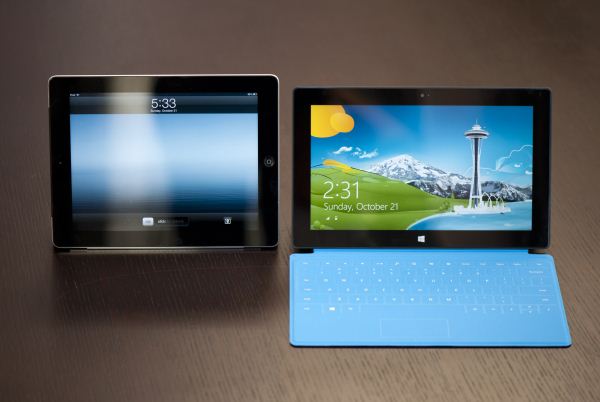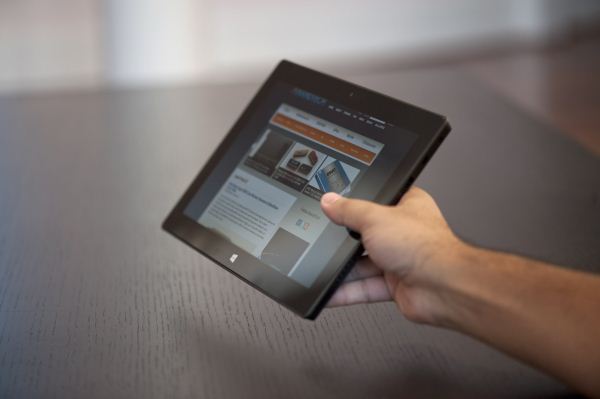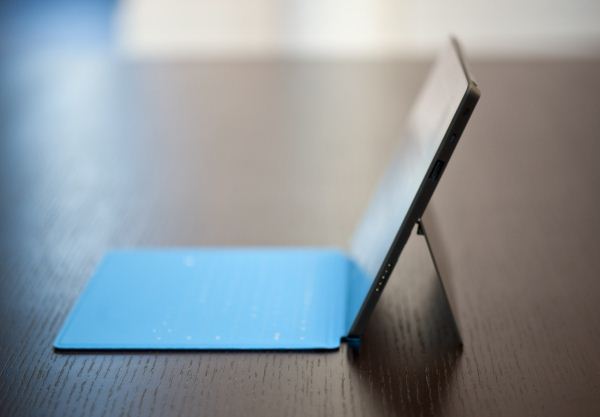Microsoft Surface Review
by Anand Lal Shimpi on October 23, 2012 9:01 PM EST- Posted in
- Tablets
- Microsoft
- Mobile
- Surface
- Windows RT
Surface: Simply Put
Surface is very well built and extremely well designed. It’s easily among the best built products I’ve had the opportunity to handle, and definitely puts a lot of earlier attempts from far more experienced companies to shame. I wouldn’t say that it looks better or worse than the iPad, it’s simply different. I talked about perspectives earlier, Microsoft’s perspective on tablets is a bit more utilitarian than Apple’s and Surface’s design reflects that reality.
Where the iPad is curvy and without any IO expansion, Surface is squared off with 22-degree beveled edges. The iPad features a light aluminum finish while Surface contrasts with its dark Magnesium surface. Not better or worse, just different.
Surface is both larger and heavier than the iPad, both design decisions on Microsoft’s part to built a device that could better deal with Windows RT’s multitasking capabilities as well as make room for a comfortable typing area when used with one of its two keyboard covers.
The added weight is offset by superb internal weight distribution. Microsoft claims a lower moment of inertia by more evenly distributing weight inside Surface’s chassis. I don’t know that I’d consider Surface light but it is very comfortable to carry around. It’s not quite like porting around a pad of paper, but carrying Surface feels very natural.
The focus on weight distribution results in a device that is honestly comfortable to hold in tablet mode and very comfortable to carry around. The more squared design of Surface actually makes in hand feel more like a book than the iPad, which was an early goal for the device.
The chassis is built out of an injection molded Magnesium, which gives it a very different feel to most machined Aluminum or plastic tablets we’ve used in the past. Microsoft calls this process VaporMg (vapor-mag) and I have to say that I’m pleased with the outcome. Surface’s finish is smooth and lacks the same texture that we’ve come to expect from machined Aluminum. The device feels very durable and doesn’t seem to scratch or scuff easily, although I didn’t purposefully try to mar my review unit over the past week. Striking a balance between robustness and light weight is very tricky business when building mobile devices, Surface easily falls on the robust side of the scale without feeling overly heavy. I never felt that the device was too fragile.
The power of Surface is in its flexibility. Microsoft’s talents not as a software developer nor as a parts assembler are what make Surface great here, rather its design and manufacturing intuition. I would’ve expected Surface to come from a company that had much more experience in designing and building tablets and PCs, not from a company that’s traditionally known for putting stickers all over them.
Surface’s flexibility comes from three areas: the tablet itself, the integrated kickstand and the optional Touch/Type covers. In tablet mode, Surface is Microsoft’s take on the new wave of tablets. It delivers the same intimate content consumption experience that you’d get from other tablets but with the added benefits of Windows RT, such as improved multitasking and better task switching.
Surface also features an integrated kickstand, also made out of the same VaporMg process as the rest of the chassis.
Microsoft wants you to be able to quickly transition between notebook, tablet and display modes. It’s rare that I see a goal so well executed. Surface really masters the art of quick transitions between all three modes. I can be in word, typing out this review and quickly switch to a tablet mode where I’m browsing the web with the keyboard cover folded neatly behind the display. If I need to respond to a comment or answer an email, I can just as easily switch back. The kickstand is a necessary part of enabling these quick transitions, and it does its job well.
There’s only one side of Surface that has a cutout for you to easily flick the stand out from its resting place. The kickstand’s range of motion does take some getting used to. It’s spring loaded enough to pop out at good velocity (and strong enough to pinch your skin nicely if you close it on a part of your finger by accident). When deployed it positions the top of Surface away from you at a 22-degree angle, matching the bevel of Surface’s edge.
With a fixed angle of deployment the kickstand doesn’t always deliver the best viewing experience, although it’s usually good enough. The kickstand is perfect for desk use and even for using while reclined on a couch or even in bed. Where it does fall short is if you’re hunched over Surface on an airplane in coach without a lot of room to move the device away from you. In those situations you’re going to find that you’d wish the kickstand could open at a wider angle.
Microsoft is particularly proud of the acoustics and feel of the kickstand. In my experience I felt the kickstand actuated nicely but I don’t know if I’d go so far as to draw the luxury car door comparison. The best way I can put it is the kickstand never feels cheap and doesn’t rattle, it works and gives you the confidence that it’ll always work and not just break after half a year. It’s not often that I find a substantial moving part on a mobile device that I feel is more functional than gimmicky. Surface’s kickstand is definitely a job well done.
The third element of Surface that makes it a very flexible device is also responsible for the splash of color in the design that gives the otherwise business appearance a consumer twist. I’m talking about Surface’s Type and Touch Covers.



















235 Comments
View All Comments
Krysto - Wednesday, October 24, 2012 - link
So their (real) excuse for using a lower resolution is that they didn't use a more powerful chip? Ok, but the problem remains that they're using a chip that can go in $200 tablets as well, a lower resolution display, and also a much smaller battery than the iPad, and yet it still costs $500.The extra storage is irrelevant, since they need that for cover for the greater size of Windows and Office, and they shouldn't make the user pay for it. Also how do they explain the fact that Google will use a much more powerful chip (Exynos 5 Dual) and a much higher resolution (2560x1600) in their upcoming Nexus 10 tablet, and yet will still cost $500 or less?
phexac - Wednesday, October 24, 2012 - link
Yeah the more comments like this I read, the more I realize that I was too generous in my post below. Surface seems destined to be a crap release and Anand did a terrible job at presenting an honest review of it.shompa - Wednesday, October 24, 2012 - link
Is WindowsRT sandboxed?If the OS is sandboxed: how do apps access the microSD slot?
I have seen many Windows Phone/Androids that have to reformat the system and reinstall everything to get the apps to "see" the microSD.
Can you install apps to the microSD?
scorpian007 - Wednesday, October 24, 2012 - link
You can't install apps to the microSD card, it's only for media (photos, videos, music).phexac - Wednesday, October 24, 2012 - link
This really seems to me like a tablety take on the netbook, and those turned out to be underpowered pieces of crap. MS looks to be going down the same road with an OS that tries to be like a desktop OS, but that can't really run all the OS programs. When it tries to run Office, it starts choking.We have no retina display.
App launch times are horrid for a tablet.
I really don't see the point of this device. If I am going to type or actually produce something, I am going to do iton my macbook air. If I want a tablet, I really don't care about a crappy attachable keyboard for $130+. If you say well I want a cheap laptop, well then you are back to the netbook argument, except the Surface is 2x or more the price, in the same price range as most fully-featured laptops, except it actually doesn't even have a fully functional desktop OS. This is a device typical of Microsoft, which never seems to think about how people will use the device and what they will want to use it for. They come up with a device that tries to straddle the fence on everything, and as a result ends up doing everything shitty (and with a shit screen, given the retina display and other displays following it being out there). Reading this review leads me to see complete and utter failure for MS in this device. And this is the reason they are making Windows 8 into an abomination? Pretty sad honestly, though not really unexpected.
N4g4rok - Wednesday, October 24, 2012 - link
"App launch times are horrid for a tablet."There weren't any numbers relating to App launch time. He made a statement about them being a little longer than he expected. How does that equate to 'horrid'?
andrewaggb - Wednesday, October 24, 2012 - link
he also said switching once they are 'open' is really fast, so this might be ok.TheBasicMind - Wednesday, October 24, 2012 - link
I think Microsoft really have something. Though I did wince reading you tried to adjust trackpad scrolling by resorting to the registry. I see the registry and access to it as part of a MS mindset that is not about openness or any positive philosophy (like LINUX), but instead about fear of having missed something. It opens up an untestable number of configurations a world of potential system problems and pain. I've not missed it in any way shape or form since moving my computing away from MS. And it is part if a computing past I have actively and willingly left behind. This is the company where still in Word, after several generations of releases, if you leave the document map open while editing cross references, you are guaranteed to have a badly corrupt document within 2 hours of working on it (GUARANTEED). How many combined years of user pain does that represent?.The only explanation for this fundamental lack of quality control is that it became like a messy room, which when mess was left long enough, just became a part of the background (I did abandon after Vista and have heard from many sources Windows 7 was a big improvement). I know other OS's have their problems (though in my experience, nothing like MS's offerings) I'm sure Surface is different (it has to be for the sake of MS). I think it may well hit the right spots for me. However over the years, the MS brand has become a kind if giant anti-brand for me and MS have to overcome that as well. They have a very high mountain to climb. So for me it will be surface 2, if and only if Surface 1 is a roaring success.Jxpto - Wednesday, October 24, 2012 - link
"Switching between applications is faster on Surface/Windows RT than any competing mobile platform. There’s no double tapping of anything, no pressing and holding, just an edge gesture swipe like you’re flipping through pages of a virtual book".That's not accurate at all... You don't even need to move your hand to the edge to switch between apps in the iPad. It's just a 4 finger gesture... And also just a four finger gesture to bring the task switcher... Or a not her gesture to go to the home screen. So in what is the Surface better regarding this??
turnipmaster - Wednesday, October 24, 2012 - link
Firstly, out of 32GB, the OS require at least 10GB+, so we know that this is no lightweight solution.The load times seem outrageous, my trusty Lumia 710, after a reboot, loads the Nokia maps app in ~2 seconds, this on an old Arm A8 based SoC. My Nexus 7, has the same Tegra 3 as the Surface as is damn sight faster at opening apps.
The wisdom of a psuedo facsimile of Windows 8, that can't run legacy / x86 apps yet obviously brings additional performance demands over a mobile focused OS, like WP8 is lost on me. If MS knew this, why didn't it chose a higher spec SoC, they haven't even used the fastest Tegra 3, the T33 would have been a nice boost over a regular Tegra 3.
I personally think WP8 could have been tweaked to be awesome on the surface, but Microsoft intended to use it to push their weird vision of Windows 8 RT. It is a shame that performance detracts from a cool device with a lot of potential, especially as Apple has blind-sided them, with a big boost to the iPad's performance with the A6X.